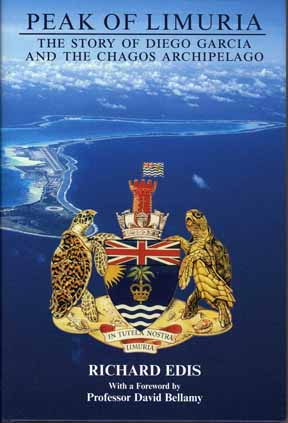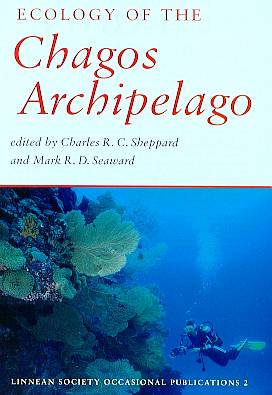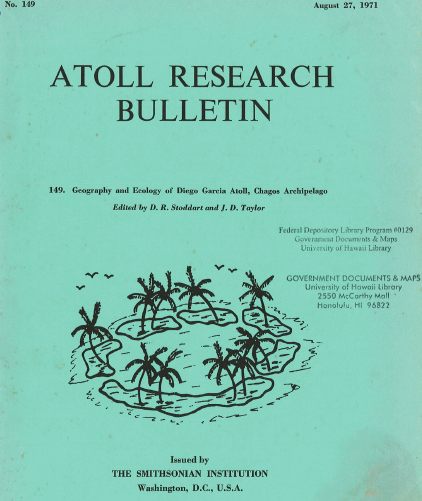Visit the Rest of The PPDRDG by Returning to the Site Map and Picking Another Page!
The
PPDRDG
Ministry of Criticism and
Re-Education Camps Presents:
Book Reviews
(Where We Tell You What To Think About What You
Read!)

(You'll find "DG for DUMMEEZ" in the nightstand next to your rack once you get out there - right beside a Gideons' Bible, a Torah, a Koran, a scroll of Confucian Sayings, the Mahayana Sutras, the Book of Mormon, Zen and the Art of Motorcycle Maintenance, the Egyptian Book of the Dead, and Mao's Little Red Book. The PPDRDG is an equal religious opportunity provider...)
 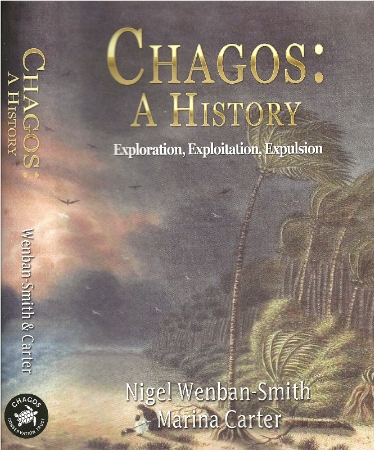 'Chagos: A History' by Nigel Wenban-Smith and Marina Carter This is
THE BEST history of Diego Garcia and the Chagos
there is! It starts out in the dark ages and
follows through until the arrival of the Americans
in 1971. EVERYONE who has read this book
proclaims it's objectivity and readability.
And, once again, I played a very, very, very
teenie-weenie part in the books drafting.
Nigel, by the way, was the British Commissioner of
the BIOT in the late 1980s, and updated Richard
Edis' famous "Peak of Limuria", and Marina is a
widely respected historian. Together they have
produced a winner of a book, and you must BUY IT,
and then READ IT, if you want to understand the
Chagos through the ages. Well, up to 1971 that
is...
You can order this book through the Chagos Conservation Trust at https://chagos-trust.org/support/shop. The cost is £40 ($52 as of November 2018).  |
|
'Coral Copra and
Concrete'
by Daniel W. Urish, Commander, CEC, US Navy (Retired) Well folks, here it is, a book about Diego Garcia by one of the men who built the base! In fact, CDR Urish arrived on DG in May 1971, and was the first Island Commander, and the Commander of the first full battalion of SEABEES to get to work on creating the U.S. base there. If you have ANY interest at all on that subject, this is the book for you! This is not a small book for one of those tiny bookshelves you've got hidden away in your den. This is an 8 & 1/2 by 11 inch, 240 page book that feels nice and heavy in your hands, and is full of weighty information. You'll want to show it to your family, while you blurt out lots of "this is where I was!" and "I never knew about that!" Like other sources (including this website), Dan uses some of the Official Propaganda Photos showing smiling sailors, bombers getting airborne, and glowing sunsets. But many of the photos are ones Dan and his folks took in those early days. About half the book is devoted to Dan's "memoirs" of NMCB 40's tour of duty, so, you'll read about everything that happened out there from the arrival of the Royal Navy Submarine HMS Orpheus to the Marijuana Plantation some enterprising SEABEES planted in 1971. And lots more. Dan also reveals in some detail how the construction was planned, landed, sustained, and even paid for. He adds lots of very interesting details about things we took for granted out there in later years - like how the island's fresh water well system was built from 55-gallon drums... One of my favorite sections of the book is the 8 pages of the paintings by Tom Veit who stormed ashore with the rest of NMCB 40, and promptly turned out a magnificent set of paintings detailing life by his fellow shipmates. About 1/2 of the book is devoted to the historical background of the island, and to some speculation about possible futures. The exploration and settlement, and the story of the islanders are briefly re-told, as are some of the military operations conducted from the island in the last 3 decades. Insight that Dan provides that other historians can not is based on his comparison of "then" and "now". He was able to return to DG in 2014, and so knows the island as it was - natives and coconut trees - and as it is, and the unbelievable changes that have taken place over the last 45 years. Dan has been working on this book for a few years, and for me, the wait was well worth it. I encourage you to contact Dan and BUY THIS BOOK! Right
now, Dan is selling it himself, and you can
email him to ask for an order form at:
harbourrose@cox.net
The cost of the book is $39. Stateside (including APO/FPO) shipping and handling is $9. Overseas shipping is significantly more. Contact Dan for the latest figures.  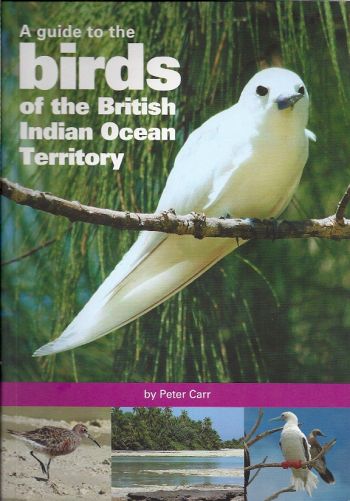 'A Guide to the Birds of the British Indian Ocean Territory' by Peter Carr If
you are at all interested in the environment of
our favorite island (and it's local
archipelago), be sure to get this wonderful
little book and keep it forever. Pete Carr
has, like most of us, been fascinated by the
Chagos and Diego Garcia for many years - first
visiting 15 years ago while still on active duty
in the Royal Marines. Eventually, he was
assigned to the British Forces on the island as
the Executive Officer, and spent two years
assembling the information that would ultimately
become this book. Upon retirement, Major
Carr became the Environmental Compliance officer
for the primary base contractor, where he
continues to care for, and learn from, the
ecology of the BIOT.
The result of that devotion to the natural history of the archipelago is clearly laid out in 110 full-color pages with innumerable high quality photographs. The first third of the book is a thorough examination of the naturaly history of the archipelago, complete with maps and concise explanations of the effect of human activities - and absence - on avian populations in the islands, and the value of the Chagos as a reservoir of species capable of repopuating other areas of the Indian Ocean once those places establish conservation priorities and policies permitting a return of some sort of balance between humananity and the naturaly world. Think "Ark". The next 50+ pages is dedicated to the 50 (coincidence? I think not) most common species of birds that inhabit the archipelago. Each page includes all the pertinent information regarding the identification of the species, the status of its population and distribution thoughout the Chagos, and specifics of where to go to see the birds and add them to your life list. Each page also has a 3.5" x 5" full-color close-up photograph of the bird that can be used to help identify the species when you spot them. And there are plenty of species to spot! In addition to the 50 you are most likely to see, there are 65 more listed with pertinent local information revealing the right spot in the right place and at the right time of year so you can catch the vagrants as they pass through or stop for a rest after being blown off course. There is even a listing of another 27 species that are believed to have been seen once or twice over the last couple of centuries. Pay close attention to that list - who knows, maybe you'll be the one who positively identifies the elusive White-bellied Storm Petrel? This is the sort of quality book you read prior to entering the field, or on a quiet, retired Saturday afternoon as you relive your time on the island. "Hey, look kids! Grandpa is reading that cool bird book again!" So, it really isn't a field guide (although you could take it with you if you wanted to), but Pete provides a list of suitable field guides to use if that is your desire. One other thing that comes through loud and clear in this book is the awe of life in the remote natural world. The Chagos is as far as you can get from where I'm sitting without heading back, and that thought makes me pick up this book not just to look at the beautiful photos, but to recapture that sense of being somewhere amazing. Pete Carr deserves all our thanks for this critical addition to a better understanding of our natural world, and reminding us of our place in it. You can order this book
through the Chagos Conservation Trust at https://chagos-trust.org/support/shop.
The cost is
£20 ($26 as of November 2018).

 'The Lords' Day' I used to start this page out with "Peak of Limuria" because it was (IMHO) the most accessible to readers, and contained the best description of Diego Garcia. Plus the fact that I helped with the 2004 revision... But I've changed my mind on the most accurate representation of our favorite island, and now believe it is found about 2/3s of the way through this fascinating book by Michael Dobbs.
'Peak of Limuria' In 2000, I wrote a
review of the 1993 edition of this work, which I
found wanting in many respects. A couple
years ago, I was contacted by Nigel Wenban-Smith,
another former Commissioner of the BIOT, who asked
if I would like to contribute to a re-write!
Ambassador Edis had sadly passed away in 2002, and
left the rights for the book to the CCT, which
intended to republish the book and offer it once
more for sale to the public. I was
surprised, and frankly honored, to be offered the
opportunity to take part in this effort, and
thoroughly enjoyed the mental exercise! Not
only was I contacted, but Kirby Crawford and Carl
Villanueva, contributors to this site, were
included in the work. Our main contributions
were to the Americanization of the atoll as
described in Chapters XIII and XIV.
Hopefully the text will relay a better sense of
the truly heroic accomplishments, and the
resultant changes to the island, over the last 35
years, thanks to those of us who spent so much
time on Diego participating in those activities.
So... the gentle reader should be aware that my effusive praise for this book might be tainted slightly by my name appearing in print in it! At any rate, here goes: This is the new and improved version of the 1993 book by the same author and title. It retains the format of the original (being a slim little work 9.5 x 6.5 inches) but significantly expanded to 104 pages of text, with a much improved photo selection. The book contains much more insight into the last decade of activities, and contains important environmental commentary as well. This book is a pleasant, quick read, and gives a very concise history of the island. Ambassador Edis wrote in a clear and interesting style, and Nigel deserves much praise for retaining that comfortable feeling throughout the added text. There are some fascinating pictures of old maps and paintings from the 18th and 19th centuries, a stunning photograph of the island from space, and some interesting charts and graphs. But mostly the book relies on the text to carry the story, and the book is funny and entertaining in places. The political and even patronizing viewpoints of the earlier edition have been, by and large, ameliorated, and the book will appeal to American and international audiences as well as those from the UK. From my conversations with the CCT committee responsible for the re-write, I believe that Mr. Edis would be pleased with the result. Frankly, this is THE gift book to give anyone who has an interest in where you've been (assuming you've been to Diego Garcia). It is stylish and attractive, and if not a compelling read, is certainly a unique addition to any bookshelf of the esoteric collector. You can buy it at the Chagos Conservation Trust E-Store. And of course, don't forget to read Chapters XIII and XIV, which are absolutely the best. You can order this book through the Chagos Conservation Trust at https://chagos-trust.org/support/shop. The cost is £16 ($21 as of November 2018).
PPDRDG President's Review: First, this review is not a peer
review, and I apologize to the dedicated scientists
who wrote the book for any criticism I might have -
far be it from me to evaluate any scholarly work.
BUT, for the typical visitor to this web site, I recommend you buy this book, if you've got about $76.60 to spare (airmail to the states, exchange rate on 10/20/00). The book is a compilation of the reports done by the members of the 1996 expedition to the Chagos Archipelago (about 20 scientists), who studied the reefs, the weather, the insects, the pollution, the nesting seabirds, etc., etc., of the islands, especially those northwest of DG. It has 24 chapters, each of which is either a short paper explaining a specific scientist's project during the expedition, or a sort of analysis of several areas of study. Each chapter has a short summary up front that explains what its going to say, and most have specific, practical recommendations for preserving or enhancing the ecology of the islands in the closing paragraphs. Considering the extreme difficulties inherent in mounting an non-military expedition to the Chagos, its amazing that there have actually been several, and this book also takes in data from those expeditions, and relates it to the current state of affairs. Some of the chapters have some really cool data in them, like how many liters of turtle oil were exported in 1904, and stuff like that. It will make all patriotic citizens of the PPDRDG happy to know that the environment of our little republic is described in several places as the most "pristine" in the IO! I think we each deserve a pat on the back for not trashing the place, picking the last living coral off the reef, or dumping heavy metals into the lagoon during our stay. Actually, I was almost offended by one suggestion at the end of one of the chapters that 'base personnel be sensitized to the plight of sea turtles' or something like that. I thought we all have done pretty well over the 30 years 'the base' has been there - the surrounding environment is BETTER than it was when the plantations were operating. A real accomplishment consider we have fought a war from the island, and the Brits only have a grand total of about 40 men and women to ensure nobody does anything environmentally harmful. But, if you can get over that kind of minor faux-pax by someone who was only out there on DG for a couple of days, this is a great book for anyone interested in DG and the Chagos. It is written by PhDs and so isn't in the standard 6th grade language our military manuals are written in, but it will read easily if you take your time, sound out the Latin names, and don't need too many pictures. This is REAL science, not the greenie-weenie kind of twisted logic, so there are lots of charts and graphs and lists, and the pictures that are in it (about 25) are really, really, good. The most important thing, I think, is that the conclusions it reaches concerning the ecology in the Chagos are the result of real science, not political bullshit. The main problem the casual reader will have with the book is that because the papers are scholarly, and subject to peer review, they assume you know the taxonomic names for all the life forms, and if you don't have a translation guide to 'common names', you'll get frustrated because you'll never figure out just what kind of birds the 320 breeding pairs of Fregata minor on Diego are... The bottom line
is that if you are interested at all in the world
around you, serious about remembering your stay on
DG from an intellectual angle, would like to astound
your friends and neighbors by being able to explain
the biogeographic role of the Chagos in coral
dispersion in the Indian Ocean, or just want to
finally, after all these years, own a book, GET THIS
ONE.

This book has long been out of print, although you can find it at rare booksellers on the web. But don't despair! You can DOWNLOAD this critically important work by going to
I first read this book in 1982 when I was TDY on the
island. The Brit Rep had a copy, and his XO,
Captain Ken Gill, graciously loaned it to me at the
time, knowing my interest in ecology. I tried to
get it copied at the base library, but they wouldn't
let me unless I supplied the paper, which of course
was unavailable. Ever since, I've regretted that
the combined bureaucracies of the USN and USAF crushed
my quest for knowledge. That's why it's so
exciting, to me at least, that it's now available on
the web. My life is complete...
As with Dr. Sheppard's work, this is not a peer review of this wonderful collection of scientific articles. My judgement would be suspect at any rate, as I remain in awe of this book (and although paperbound, it is an 8.5 X 11 book of 294 pages). Stoddard and Taylor compiled this series from their work on Diego in June and July 1967 with the British hydrographic survey aboard HMS VIDAL. It is fascinating to read about the island before the arrival of the Americans. Ever heard of Barrachois Sylvain? Today we know it as Turtle Cove. Reading this clear and concise book is like reading about your hometown before you were born. For example, did you know that there was a huge 'barrachois' (bay) where Camp Justice now sits? The main reason you should read this book is that it is widely held to be THE definitive snapshot of Diego Garcia after 150 years of cultivation and basically hunter-gatherer inhabitation, but before industrialization and the construction of the base on the western arm of the atoll. Every subsequent author cites this reference, if for no other reason than to contrast current conditions from those in the late 1960s. This alone makes it worth the effort to obtain and digest.
Stoddard gives some hints of his anti-military
perspectives, which are more developed in later works,
but this should not deter the serious
reader. So, my whole-hearted
recommendation is to READ THIS BOOK. Do it
today.

I thought that you or your readers might be interested in a book that has recently become available. It is "Diego Garcia: Creation of the Indian Ocean Base" by Vytautus Bandjunis, ISBN 0-595-14406-3, Writers Showcase 2001. Bandjunis worked for "Yards and Docks" back in the 60s when the US first began getting serious about a base in the IO. The book is fairly short (300 pages with appendixes) and a straightforward read, primarily from the point of view of a top manager. There is a lot of stuff about budget reconciliations and bureaucracy and such that a lot of people probably wouldn't find too interesting. Amongst it, however, there is a lot of "Cold War" background material and some interesting pictures and factoids about everyone's favorite island. The book really starts with the 1964 joint US/UK survey team and carries on from there as plans are made, then unmade, money is budgeted, then unbudgeted, and eventually it is all made to work out, sort of. The book does not go in depth into the diplomatics of the situation but does give an outline (and how many books even *mention* the subject?). The 'relocation' of the Ilois is also mentioned but is not dealt with in depth. The book is a nice slice of both "cold war" history (oooh, those nasty Russians are coming!) as well as an example of how messy projects like building a base in the middle of nowhere can be -- with the US, UK, India, Mauritius, USSR - not to mention USN, USAF, GAO, Congress etc. all sticking their fingers in the pie at various times.
The
"Stars and Stripes" bookstore on DG (is there
still one?) ought to keep this in stock.
Regards, Steven J. Forsberg. 
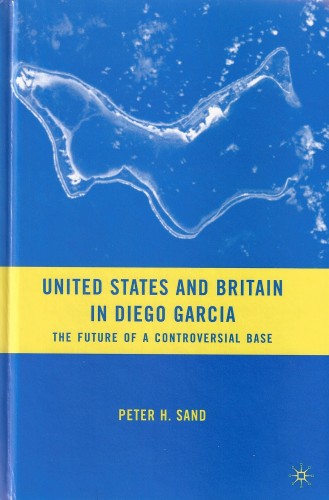 'United States and
Britain in Diego Garcia, Peter Sand has produced a very
important book for the serious student of Diego
Garcia, the end of the British Empire, war and
diplomacy. Peter, and I call him Peter for we
are friendly correspondents if not in agreement on the
issues covered by this book, is a Lecturer in
International Environmental Law at the University of
Munich and author of numerous papers along those
lines. This book primarily addresses the
peculiar legal issues of environmental regulation in
the BIOT, a colony without colonists. Although I
don't think Peter sets out to fool his readers, only a
very careful reading will reveal that most of his
criticisms are along these lines: "Most nations
with colonies have signed the treaty to do X both at
home and in the dependencies. The UK has signed
Treaty X, and abides by it in the UK. However,
it has not extended that treaty to the BIOT. It
should do so, and if it did, then the following would
be required/ prohibited/ regulated/etc., and the UN
would be present to ensure compliance."
He infers from the events surrounding the Chagossian expulsion that everything that goes on in the BIOT is equally confusing and, well, wrong. For example, since there is no international commission monitoring the BIOT's environmental health, he leads the reader to believe that it is a cesspool of radiation, fuel spillage, and invasive species. Although all the science conducted by others in the Chagos and in and around the Diego lagoon says otherwise, it is the lack of international oversight that Peter bemoans, and (I am convinced) fuels his rhetoric demanding such oversight. His ultimate arguement is that because international treaties and various laws do not extend to the BIOT, the Territory is in a legal (and to Peter, ethical) black hole. Peter also dismisses the defense rationale for the establishment of the BIOT and its use to defend Western civilization, first from the USSR and currently from radical Islam. He does not hold with the idea that military secrecy trumps public access, and with other writers like Vine, he repeats the Chagossian mythology in demanding their return, and sees no problem with their return to these environmentally sensitive islands or the political impact on American and Western security. Peter is a careful but concise writer and makes his points in just 67 pages of text. The real value of the book however is the inclusion of every important document regarding the US/UK agreements about the Chagos in 75 pages of Appendices, and another 45 pages of detailed footnotes. Although I sometimes find that the reference cited does not support the text, the inclusion of such a voluminous set of endnotes serves as a comprehensive bibliography of articles and publications about the BIOT and Diego Garcia. At £50 (about $75 in Sep 09) you may not wish to invest in this book, although I recommend you do. You can get it through Barnes and Noble, Amazon, and through the publisher, Plagrave MacMillan.  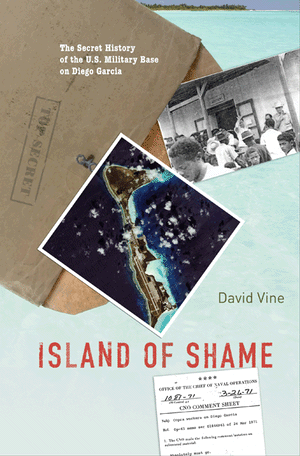  'Island of Shame' This
is the defining book of
the 21st century
arguments surrounding Diego
Garcia, the B.I.O.T. and the
Chagos Archipelago, and a
must-read for anyone
interested in understanding
the left's invented mythology
of the islands and their
former inhabitants, and their
desire to destroy the United
States and by extension
Western Civilization.
Before talking about what little substance exists in this shameful collection of exaggerations, it is reasonable to discuss what Dr. Vine is trying to accomplish. The Preface by the former head of the Students for a Democratic Society (SDS) at Berkeley, and defender of Angela Davis, Terry Nichols, and any number of other racists, class warriors, killers and bombers should be sufficient. Michael Tigar bluntly says of Vine, "He sees the Chagossain people in the context of global struggle." This is classic communist code that everyone who reads this book should understand. Dr. Vine also spends much of pages 12 and 13 of the introduction describing how he was courted by Mr. Tigar and eagerly assented to participate in the proposed lawsuits against the United States (in Dr. Vine's world view, only the U.S. is evil and deserves to be dismantled - the UK is just a sideshow). We also have Dr. Vine's mother's confimation on the title page of the book that I purchased 2nd hand from a library in Connecticut. It says, "Dear Doris, It is an honor to inscribe my eldest son's book to the Gau Greatest Teacher! It was he who brought us to the Gau Family, where we met you and your values of kindness and friendship. Although David was not lucky enough to be a Puppy, he embodies Tikkun Olam* and your mission. With gratitude and respect and love, Marsha 05-29-09 Shavout." Dr. Vine has appeared on Book TV and has spoken in dozens of venues since taking up Olivier Bancoult's cause, and according to his CV in the Department of Anthropolgy at American University, his entire academic life consists of seeking, and speaking in favor of, the demilitarization of America. He appears to have no visible means of support and claims that all profits to this book go to 'support the Chagossians'. According to both Vine and Tigar, Tigar provided Vines expenses from 2001 through 2007, although both deny this constitutes "hiring", and I find it fascinating that Dr. Vine was accepted to the Ph.D. program and is now an Assistant Professor at him mentor's place of employment. Meanwhile, Dr. Vine presents himself to the public in a calm and almost mystical manner, which to the unprepared can lead to belief that his book is actually the result of an Anthropological study, when it is nothing more than propaganda to aussage Dr. Vine's sense of social equity. Rather than studying a population and coming to a conclusion, he accepted Tigar's explanation of the islanders' plight and proceded to cherry pick statements (so many are outright lies that is impossible to call them 'facts') to justify his opening premise. So, in addition to being an anti-American and anti-Western Civilization diatribe, it is also junk 'science'. There are two themes of the book - the first being that the United States has created an 'Empire of Bases' from which it exercizes hegemony over the entire planet, and that this is evil. The second is that in the process of establishing the base at Diego Garcia, the United States and Great Britain perpertrated genocide on the peoples who lived there. On May 19, 2011, I heard him speak in London at a program presented by Patrons of the UK Chagos Support Association, and the conclusion of his speech was that the reason the US required the removal of the Chagossians was that they were black. It was a clear attempt to play the race card when nothing except one single reference to "man Fridays and Tarzans" made 40 years ago can be found in any record. In one sentence, Dr. Vine dismissed the entire Cold War, the clash of ideologies and the context of the times in favor of a blanket, undocumented lie. What is amazing to me is not that some civil servant made the Tarzan a statement, but that in the entire history of the B.I.O.T. there has only been one such statement recorded. The point is that claiming racism as the cause of the clearances is pure bullshit, and I told Dr. Vine so, straight to his face following his talk. Not that it made a dent in his race and class struggle vision of the world. Dr. Vine is a brilliant writer, and a persuesive speaker. However, if you have any rational thinking ability at all, or some previous knowledge of the history of the Chagos, and apply it to supposed non-fiction such as this, you will be awoken from your trance on each and every page by an outright lie in the text, documentation that links to nothing more than an editorial in a leftist blog, or bald-faced statements that smack of falsehood and have no footnote. In the first narrative paragraph of his Introduction alone, Vine states as fact, without attribution, four lies that were disproved in testimony in British Courts - that 2,000 islanders were expelled, that the UK systematically starved the islanders and withheld medical supplies, that the islanders were forcibly evicted and abandoned in Mauritius, and that U.S. troops killed the islanders pets in front of their owners. Please see the account of the British Court Cases for the truth of these events. Despite an entire book full of conjecture, anti-Western hatred, and outright lies, there is no doubt in my mind that you should read this book. It is classic Soviet-style Intellectual-Marxism Disinformation by a clever wordsmith, and a refreshing change from the subtle propoganda we must suffer through daily from modern governments, anarchists, radicals of other religious stripes, and NGOs. * According to myjewishlearning.com, the Hebrew phrase tikkun olam (pronounced tee-KOON oh-LUHM) means "world repair." In modern Jewish circles, tikkun olam has become synonymous with the notion of social action and the pursuit of social justice. 
'Coma Story' Some
time
ago, Dr. Thompson contacted me and asked if I could
provide information and photos of DG for a novel he 
"A Few Man
Fridays" Performed at Riverside Studios, Crisp Road, Hammersmith, West London Review
from an anonymous friend:
Ladies and Gentlemen, 
But Wait! There's More!
These are the same books for sale in the Stars & Stripes Bookstore on DG, and now you don't have to go back to get them - you can now buy them direct...a couple are co-authored by Charles Sheppard, and some by Commander John Topp, who was Brit Rep out there in 1986, and a very dear professional friend of mine (that's an inside joke). You can get one of CDR Topp's reports from the University of Hawaii. Go to their web site, scroll down to No. 313, "An annotated check list of the flora of Diego Garcia, British Ocean Territory" and click Dowload PDF File. It's not as pretty as the booklet for sale, and has no photos, but if you'd like a list of the plants you passed out in while you were out there, well, you can get it there. Indian Ocean Area Books
and Maps for Sale - Larry Bowman's site where
you can buy (or sell) books, prints, and
maps about the IO, including the BIOT and
Diego Garcia. This is where I got my
copy of Atoll Research Bulletin No.
149. Give it a try, if you're really
interested in rare and intriguing stuff.  |
Visit the Rest of
The PPDRDG by Returning
to
the Site Map and Picking Another Page!
Want to use something from this site? See
the TERMS
OF
USE.
T

